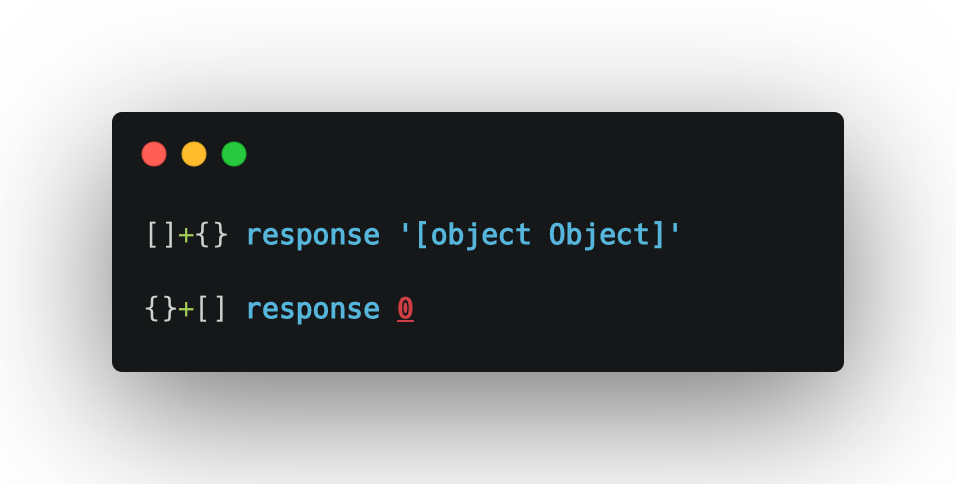This content originally appeared on Bits and Pieces - Medium and was authored by berastis

JavaScript is a dynamic, versatile language with a wide array of features, including its unique approach to handling type coercion during various operations. This flexibility can lead to unexpected behaviours, especially when dealing with the plus operator, which can perform both addition and concatenation. In this Medium post, we will explore the intricacies of JavaScript’s type coercion and the plus operator through a practical example, enhancing our understanding of this fascinating language.
Example: Adding and Concatenating Arrays and Objects
Consider the following two expressions in JavaScript:
- [] + {}
- {} + []
At first glance, it might be unclear what these expressions will evaluate to, or even if they are valid JavaScript code. As it turns out, both expressions are valid and produce different results due to JavaScript’s type coercion. Let’s break down each expression:
Expression 1: [] + {}
In this case, the plus operator + attempts to concatenate the empty array [] and the empty object {}. To perform the concatenation, JavaScript coerces both operands to strings. The default string representation of an empty array is an empty string "", while the default string representation of an empty object is "[object Object]". Therefore, the concatenation yields the result "[object Object]".
Expression 2: {} + []
Here, the plus operator + tries to add the empty object {} and the empty array []. JavaScript coerces both operands to numbers in this scenario. The default numeric representation of an empty object is NaN (Not a Number), and the default numeric representation of an empty array is 0. Performing the addition with NaN results in NaN. So, in this case, the expected result is NaN, not 0.
It is important to note that if you were referring to evaluating the string expression "{}+[]" with a function like eval(), it would treat the expression as a block and an array, which would not result in 0. Always consider the context of your code.
Conclusion
JavaScript’s type coercion and the plus operator’s dual functionality can be a source of confusion for developers. However, understanding the underlying principles can help you write more robust and predictable code. By closely examining the language’s behavior in various situations, we can gain a deeper appreciation for its flexibility and power.
When working with JavaScript, always remember the following:
- The plus operator + can perform both addition and concatenation, depending on the context and the types of the operands.
- Type coercion can lead to unexpected behaviours, especially when dealing with mixed types.
- Familiarize yourself with the default string and numeric representations of different data types, as these play a crucial role in type coercion.
By keeping these points in mind and studying real-world examples like the ones above, you’ll be better equipped to handle JavaScript’s idiosyncrasies and harness its full potential. Happy coding!
Build Apps with reusable components, just like Lego

Bit’s open-source tool help 250,000+ devs to build apps with components.
Turn any UI, feature, or page into a reusable component — and share it across your applications. It’s easier to collaborate and build faster.
Split apps into components to make app development easier, and enjoy the best experience for the workflows you want:
→ Micro-Frontends
→ Design System
→ Code-Sharing and reuse
→ Monorepo
Learn more:
- Creating a Developer Website with Bit components
- How We Build Micro Frontends
- How we Build a Component Design System
- How to reuse React components across your projects
- 5 Ways to Build a React Monorepo
- How to Create a Composable React App with Bit
- How to Reuse and Share React Components in 2023: A Step-by-Step Guide
JavaScript Quirks: Exploring the Dual Nature of the Plus Operator and Type Coercion was originally published in Bits and Pieces on Medium, where people are continuing the conversation by highlighting and responding to this story.
This content originally appeared on Bits and Pieces - Medium and was authored by berastis
berastis | Sciencx (2023-04-17T08:45:22+00:00) JavaScript Quirks: Exploring the Dual Nature of the Plus Operator and Type Coercion. Retrieved from https://www.scien.cx/2023/04/17/javascript-quirks-exploring-the-dual-nature-of-the-plus-operator-and-type-coercion/
Please log in to upload a file.
There are no updates yet.
Click the Upload button above to add an update.
